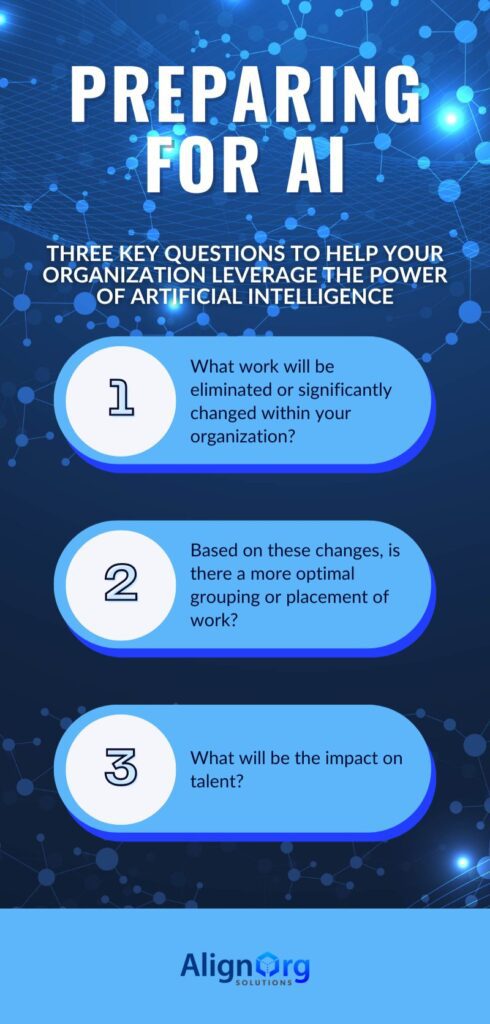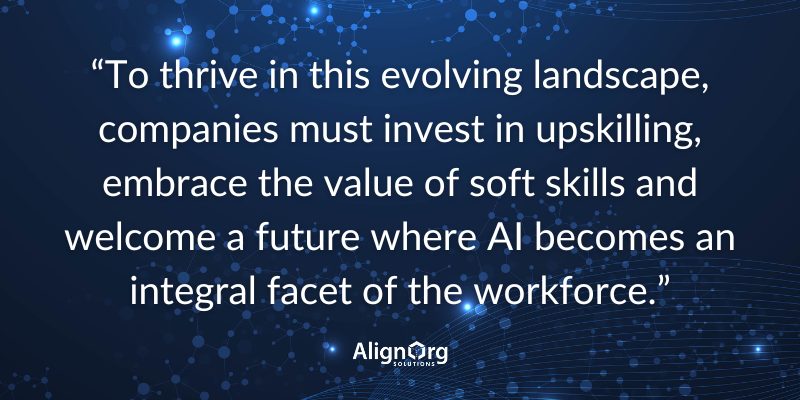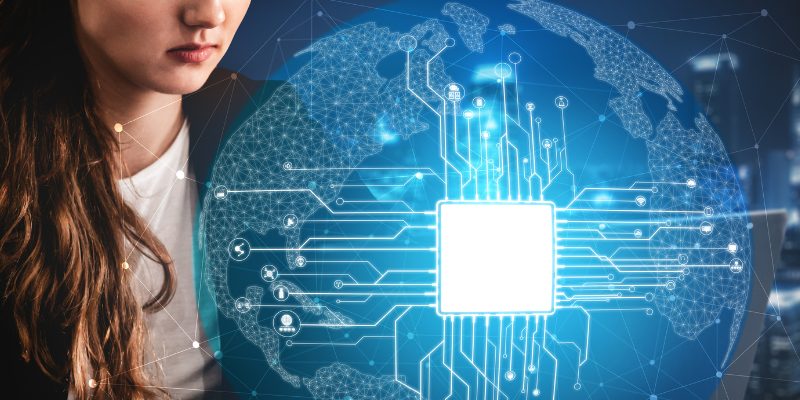Al's relentless forward march is reshaping the essence of work and fundamentally altering how businesses operate on a practical level. As one of our clients termed it, the spin around AI seems like a "frantic FOMO" (fear of missing out). While there is certainly a need to ensure the energy being directed to AI is delivering value, prioritized across all initiatives, and aligned with strategy, the continual advancements in AI cannot be ignored. More than 80% of decision-makers taking part in a McKinsey Al study recognized the inherent value of Al insights, underscoring the return on investment it offers. Let's take a deep dive into Al's influence on the organization and shed light on how it is redefining organizing systems.
AI Implications on Organization Systems
Organizations are complex systems of choices. A pragmatic way to explore AI's impact is to consider its implications for each system.
1: Transformation of Work
Let's be clear: Al is not here to supplant human workers. It is here to empower them. At the heart, Al frees organizations to redeploy their talent into more value-driven areas and to elevate an individual’s abilities. It allows us to be more intentional about placing human beings at key inflection points that leverage the strengths only humans can bring.
Take customer service, for instance. Al-powered chatbots are becoming a cornerstone of modern customer service. They can handle routine customer inquiries, from order status checks to product information. This relieves human customer service agents of these responsibilities so they can focus on the interactions that require empathy and judgment.
In the financial sector, Al takes the reins in automating data entry and processing. Intelligent systems can extract and categorize data from financial documents, reducing the need for manual data input.
Marketing is also seeing the benefits of partnering with AI. It is significantly accelerating content generation by churning out articles, turning them into social media posts and quality-checking content. It even provides analysis of what kind of content performs the best and suggests content ideas and relevant information to include.
It's important to remember that AI is a tool, not a replacement for human creativity. The best results come from a collaboration between AI and human expertise. AI handles the heavy lifting and provides insights. Humans bring the creative spark, strategic direction, and, above all, good judgment.
2: Reducing Hierarchies and Democratizing Decision-Making
The average Fortune 500 company wastes millions each year as a result of time and productivity lost to inefficient decision-making. AI may change this as it helps to break down hierarchies and make decision-making more accessible.
It accomplishes this by simplifying complex data. Technical information becomes more digestible, enabling faster and more collaborative decision-making. Where once entire subgroups would be left out of certain decisions or made to feel "othered" by knowledge gaps, it's now far easier to share insights across the board.
Al is set to redefine the contours of management, challenging traditional roles and structures. As managers have AI tools, they need less time to monitor the performance of their teams. As a result, organizations will become flatter with wider spans of control. Where middle management is still required, their roles will change from direct supervision to coaching, continually developing their teams in areas like data analysis, critical thinking, and change management. Management will also be advocating for their team’s access to data and enabling the AI human partnership.
3: Shift From Reacting on Lagging KPIs to Acting on Predictive KPIs
Al's prowess in processing datasets and identifying intricate patterns and trends is also changing how organizations collaborate.
Never before have we had this level of access to data-driven insights. These insights help foster more astute decision-making throughout the organization. In one instance, Unilever is using Al to spot early signs of deforestation in areas used to harvest palm oil. Managers get real-time alerts and can take action quickly before more serious damage is done.
4: Augmented Roles
The nature of roles themselves will change. A significant portion of work will be done by AI, typically automation or prediction. The rest, typically the judgment side of the responsibilities, will be done by humans. Early studies of AI's effects have found it can often lead to a 20 to 80 percent improvement in productivity across a wide variety of job types, from coding to marketing.
The question, then, becomes, what will our workforce do with their free time to achieve the results of the organization? While some experts foresee Al generating new job prospects, organizations need to prepare for the profound transformations it brings to the workforce. Selection will include the ability to partner with AI, interpret AI outputs, and leverage AI capabilities. Talent development will include upskilling the workforce to ensure they are ready and able to adapt and thrive. Retention will need to focus on avoiding the implications of "bored out" (vs. burn out), ensuring we are thoughtfully reallocating our talent to the activities that matter most.
We don’t yet know all the new roles that might be created to fully take advantage of AI. We can forecast that roles that focus on significantly advancing a function’s use of technology will change from the team member who creates reports or administers the system to something significantly more sophisticated. The expectation is that each function will require talent that’s waking up every morning thinking about the most impactful ways to leverage AI and other more advanced technologies.
Where To Start
It's difficult to say exactly how Al will impact the organization going forward, but one thing is certain—we'll see continual change. While the implications may seem overwhelming, to keep it simple and actionable, start with these key questions:

- What work will be eliminated or materially changed in your organization?
-
- Where will the work be augmented so that employees can focus on work that requires judgment or empathy?
- How will an increased availability of leading (vs. lagging) KPIs significantly change work activities?
- What work will be primarily automated and what is the impact on staffing?
-
- Based on the change of the work, is there a more optimal grouping and placement of the work in the organization?
-
- Where can you empower decision-making lower in the organization?
- Where is centralization of the work able to accelerate the use of AI and a drive for efficiency?
- Where does AI allow you to decentralize the work to bring the judgement aspect of the work closer to the customer?
- What are the implications of the spans and layers in the organization? Fundamentally, how can we rethink the role of the manager?
- What governance mechanisms are becoming outdated and slow down the organization?
-
- What is the impact on talent from selection to development to retention?
-
- How can we reallocate or upskill workers who have had their workloads reduced or eliminated through AI?
-
How can we thoughtfully reallocate activities to keep talent stimulated and engaged?
-
Harnessing the Power of AI
Al represents far more than a mere technological innovation. It has triggered an evolution in the very nature of the work we do as human beings. It unshackles employees from the mundane, amplifies collaboration, democratizes decision-making, and orchestrates a harmonious synergy between humans and machines. While the impact of Al may differ across industries, its adoption is accelerating, ushering in more streamlined and productive organizations. To thrive in this evolving landscape, companies must invest in upskilling, embrace the value of soft skills, and welcome a future where Al becomes an integral facet of the workforce.

As Al continues its inexorable evolution, it has the potential not only to revolutionize how we work but also to infuse work with greater meaning and fulfillment for employees worldwide.
Wondering how to manage inevitable transformations as an organization? We're experts in organization design, and we are here to help you stay aligned as Al technology continues to augment your workforce. Contact us now to get started.





